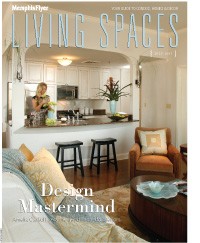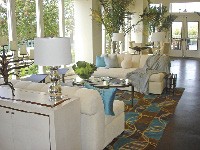Terry Lynch is driving me around the South End neighborhood in downtown Memphis on a recent sunny August morning. The past, present, and future collide in Lynch’s descriptions of the scenery as we glide in his SUV along Riverside, Front, Tennessee, Georgia, Carolina, G.E. Patterson, and the half-dozen other streets that interlace and create natural borders for the  Courtesy of Dalhoff Thomas Daws
Courtesy of Dalhoff Thomas Daws
neighborhood. Lynch explains how South End developed, the work and cooperation and money that is transforming a former industrial area into one of the premier new neighborhoods in the city. His words also conjure images of the community as it will be in a few years, when projects are completed and planned improvements are installed.
Lynch should know. The president of Southland Capital Corporation is one of the key leaders in the South End development. Involved in building the community for about six years, Lynch affects a kind of constant gardener role along these streets, mindful of even the smallest details as he grows and grooms the neighborhood toward completion.
“This is our first pocket park,” Lynch says, like a proud papa, of the fountain standing at the corner of West Georgia and Tennessee. “I cut a deal with Henry [Turley, owner of South Bluffs, which the park adjoins], and we rebuilt that wall. We paid a quarter-million dollars putting this in on this corner. It’s on [Turley’s] property, but it gives you an idea of how we’re committed to making this a connected [neighborhood].”
Among other beautification efforts in South End are new streetlights and street trees. Light poles will be equipped to hang banners touting seasonal events such as the RiverArtsFest or Memphis In May. Railroad underpasses at several key locations have been redone by the city and act as a gateway into the district. The city will also be putting sidewalks, curbs, gutters, and streetlights along Tennessee Street between G.E. Patterson and Georgia.
When Lynch started South End, “it was mostly old industrial uses,” he says. “At that time, we hired Looney Ricks Kiss to help us develop a conceptual master plan to give us some guidance and a plan to develop it so that we didn’t wind up with just a bunch of condominiums but had at the end of the day a mixed-use, New Urbanist-type community.”
These days, Lynch has his own high-profile building in development. Art House, being installed in the Cummins Mid-South building on Riverside Drive and West Georgia Street, is in the design stage under the guidance of JBHM Architects and lead architect Michael Walker. Once it begins, construction on the residential phase will take about 12 to 15 months, with commercial following. All told, it will be about a 30-month process.
Lynch imagines a development that plays nice with the neighborhood.
“We have the site under control, and [there are] public improvement contracts we’re making with the city, so we’re improving the street next to our building, next to our neighbor,” he says. “We can blend and make that a seamless experience, a neighborhood rather than just being isolated to what we’re doing.”
Art House will be a different animal from other downtown condominium developments, Lynch says.
“The quality and the price point will have to be on the high end of the range of where the market is today. So what we’ve had to do is to make something completely unique to the marketplace from a design perspective and from a use perspective.
Terry Lynch
 Courtesy of Paradigm Productions
Courtesy of Paradigm Productions
The former headquarters of Cummins Mid-South on Riverside Drive is the site for a new mixed-used development called Art House.
“It takes into account the value of connecting to the external components of this building,” Lynch continues. “The street level will be a very elaborate courtyard, the rooftop deck will be a communal place, and on the street level, there will be restaurants and bars. The South End will actually evolve to the next level of the vision, which is a connected mixed-use, on-street kind of neighborhood.”
The commercial element of Art House promises to be one of the more exciting aspects of the development, especially for South End residents. Among proposed businesses to be located on the ground floor of Art House are a grocery store, bank, coffee shop, restaurants, and health facility. The neighborhood grocery store would be about 12,000 to 15,000 square feet. “We’re working with the Center City Commission and talking with two or three operators to try to create the right incentives to make it happen,” Lynch says.
“The residential will drive the deal,” Lynch says. “We’ve got to do that first before we come back in and do the commercial. But there is a lot of interest because this will be the center commercial hub of the whole development.
“At the same time, we’re trying to get some public commitments from the city to make some infrastructure improvements,” he says.
The goal is to make the neighborhood more pedestrian friendly. In the next few years, there will 1,500 people who live within a football field bordered by Georgia Avenue and Kansas Street, Lynch says. Among that number will be residents of the Horizon, which recently broke ground on its first phase. Art House hopes to fill a void in restaurants and other businesses that are pedestrian friendly.

“That’s the kind of external amenity we see that people are attracted to,” he says. “Having them right at your front door is a big amenity.”
Above the commercial floor, Art House will have three levels of condominiums. All told, it will contain 96 condo units, a central courtyard, a rooftop communal area, and 100 parking spaces for residents in the basement of the building.
“With the Horizon, Art House, and what we’re doing on the street, this encompasses the next phase [of South End],” Lynch says.
“Right now, the market’s been soft to some extent because there was so much inventory that hit the market last year,” he continues. We do see a steady demand, but there had been a lot of product, and a lot of that product is starting to burn off. We’re watching that to see which ones are moving, because we can tweak each of our products. We’re not stupid. We’re not just going to build and assume anything sells.”
The recent nationwide sub-prime crisis hasn’t hit downtown Memphis very hard, Lynch says.
“If you look at the typical buyer for downtown Memphis, very few of them were depending on sub-prime loans to get into the marketplace,” he says. “Overall, the market has been soft. There are a lot of people sitting on the sidelines waiting for the next wave of what the lending products will be. We see the Federal Housing Administration (FHA) as being the new sub-prime lender. That’s what they were before. Starting the first of the year, FHA is going to have a zero-down loan program up to about $275,000.”
Art House looks to position itself at the top of the food chain in terms of price and amenities.
“The kind of product we’re building, we’ve got to be a high price point, because our cost of construction is high,” Lynch says. “So what we’ve had to do is go out in the marketplace and determine what design elements we can incorporate that no one else has. Since we’re starting from scratch, we were able to put in some new design elements. A lot of times you’ve got an existing building and you’ve just got to live with what it is and where it is.”
Lynch is working with Red Deluxe to develop the Art House brand, getting into the psychographics of the people who will live here.
“We’re incorporating that into branding the Art House and embracing the exterior on street elements of what our vision is for South End,” he says. “We’ve studied [potential buyers’] lifestyles to understand how they live: Where the docking stations are for their iPods, where would they want their flat-screen TV, how they cook. What’s more important: more counter space in the kitchen or a vanity in the bathroom or a bigger balcony? We are tring to understand the lifestyle of those people and put those into a design element.
“Rather than somebody saying, ‘I’m getting 1,500 square feet and you’re only giving me 1,200,’ we’re going to have such a wow factor in the 1,200 that they’ll pay us just as much as they would someone else who has 1,500,” Lynch says.
One example of the details considered by his design team: a community library where residents can exchange books. “It’s a concept beyond what they call real estate by the pound, where people are saying there’s something different here.”
Lynch’s design team meets weekly to push and prod floor plans, tweaking them to achieve maximum resident-friendliness.
“We’re thinking our way through how somebody actually functions in these units,” Lynch says. “We are trying to take it one step further, so that in addition to having a floor plan, we’re going to be able to show alternate designs and even furniture placement in these units. We’re going to give [buyers] an allowance that says, okay, here’s how you can express yourself. You decide what’s important to you. Is this a linen cabinet or another flat-screen TV, an upgraded sound system or an upgraded dishwasher?
“Whatever is important to their lifestyle, they can customize the unit,” Lynch explains. “And we’ve already selected it for them. That’s how detailed we’re getting — which we have to.
“We feel like we’ve got to be over the top with this product and over the top with this development to be something unique to the marketplace,” he says.
Lynch doesn’t mince words about his expectation for his project and its place in the South End: “It will change the shape of things down here.” ■




 Courtesy of Dalhoff Thomas Daws
Courtesy of Dalhoff Thomas Daws 
 Courtesy of Paradigm Productions
Courtesy of Paradigm Productions 

 Greg Akers
Greg Akers